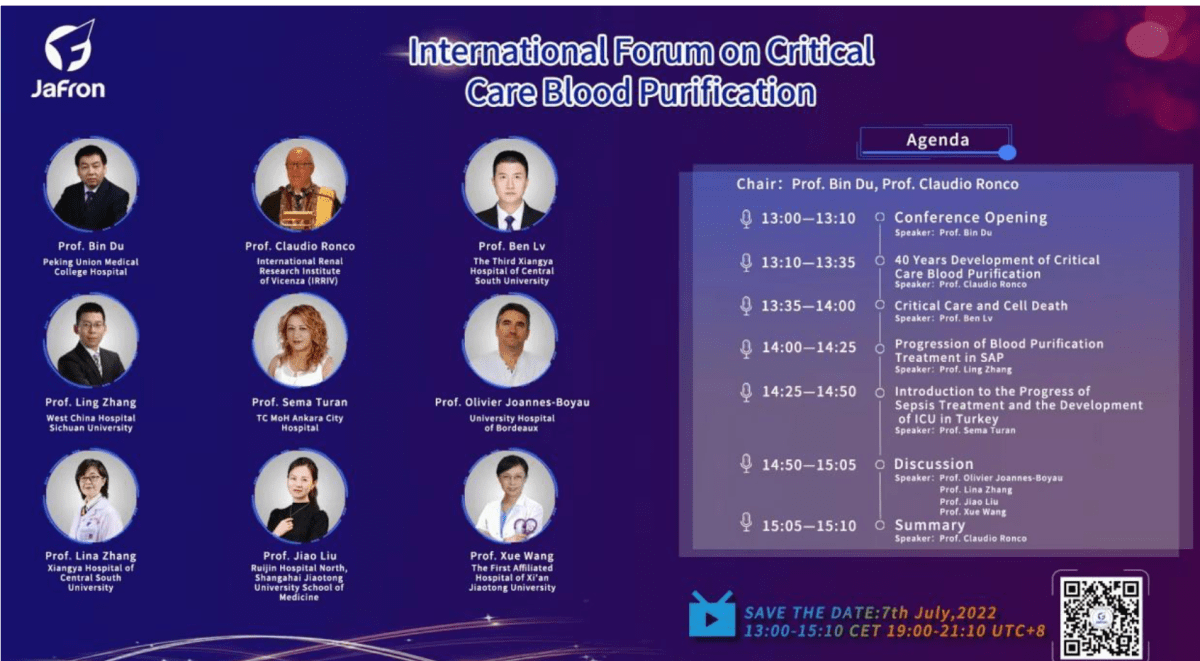On July 7th, the International Forum on Critical Care Blood Purification was successfully held by Jafron Biomedical. Approximately 2,000 global critical care experts from 43 countries attended the conference. At the forum, Prof. Claudio Ronco, Prof. Lv Ben, Prof. Zhang Lingand Prof. Sema Turan conducted in-depth discussions on critical care blood purification. In addition, the development of critical care blood purification was also shared and discussed. This forum aims to give healthcare providers a better understanding of how hemoperfusion is used in critical care.

Sepsis is one of the severe diseases, an extreme response of the body to infection, and it’s the disease with the highest mortality rate in the ICU. Infections that lead to sepsis mostly start in the lung, urinary tract, skin, or gastrointestinal tract. Sepsis can rapidly lead to tissue damage, organ failure, and death without timely treatment. [1] For its treatment, blood purification is one of the most important therapies.
Prof. Claudio Ronco mentioned that to treat sepsis, the first step should be conducting the adsorption therapy to remove endotoxin, then focus on tackling the immunomodulation and removal of cytokines. Therefore, blood purification treatment is of great importance in reducing cytokine damage and achieving a state of immune balance. Prof. Sema Turan also mentioned that extracorporeal blood purification methods are an emerging field, and an early and appropriate intervention of dysregulated host responses that benefits the patients’ clinical outcomes.
On the other hand, Prof. Lv Ben’s paper pointed out that if PKR is inhibited, the occurrence of lethal conditions caused by sepsis can be inhibited. In addition, Prof. Zhang Ling stated that DFPP-dual plasma filtration perfusion is beneficial in hyperlipidemic pancreatitis. It can quickly reduce blood lipids to an appropriate range, shorten patients’ hospitalization time, and reduce triglyceride levels. During the forum, Prof. Claudio Ronco, Prof. Zhang Ling and Prof. Sema Turan all emphasize on the essence of Hemoperfusion technology.
Jafron, as a global provider of technology, product and therapy service in the hemoadsorption industry for more than 20 years, is proud of introducing our solutions to the world, such as HA380, according to the published literature-Early Cytokine Removal in Critical COVID-19 Patients with Extracorporeal Therapies, in which says it can help to improve the organ dysfunction or failure, respiratory failure, shock or septic shock, etc.Also, its non-specific cytokine adsorption characteristics make it an option for combating critical illness.[2] On the other hand, in the literature on Extrapulmonary Sepsis-Induced Acute Lung Injury by Hemoperfusion With Neutral Microporous Resin Column, where HA330 hemoperfusion therapy alone or in combination with other extracorporeal blood circulations has been approved to be useful and can provide a new solution to reduce inflammatory mediators and cytokines for critically ill patients in ICU. [3]
At the end of the forum, Prof. Du Bin, Prof. Claudio Ronco, Prof. Olivier Joannes-Boyau(one of the main members of Jafron‘s overseas expert team), Prof. Zhang Lina, Prof. Liu Jiao and Prof. Wang Xue jointly discussed the specific applications, main challenges, and future development of critical care blood purification.
The International Forum on Critical Care Blood Purification was an excellent opportunity for participants to gather information about blood purification technology applied in critical care. Jafron Biomedical was honored to host this international conference. If you wish to learn more about this international forum, please click here to view the full video. For the previous content, please visit JafronClub website.
Reference:
[1]What is sepsis?https://www.cdc.gov/sepsis/what-is-sepsis.html
[2] Early Cytokine Removal in Critical COVID-19 Patients with Extracorporeal Therapies (HA-380 plus High Volume Hemofiltration) May Prevent Progression of Acute Respiratory Distress Syndrome: Case Report https://pubmed.ncbi.nlm.nih.gov/33264786/
[3]Effect on Extrapulmonary Sepsis-Induced Acute Lung
https://www.jafroninternational.com/uploadfile/202112/1ec550538e8b.pdf